2-叔丁基-4-羟基茴香醚

2-叔丁基-4-羟基茴香醚结构式

|
常用名 | 2-叔丁基-4-羟基茴香醚 | 英文名 | TBMP |
|---|---|---|---|---|
| CAS号 | 88-32-4 | 分子量 | 180.24 | |
| 密度 | 1.009 g/cm3 | 沸点 | 293.3ºC at 760 mmHg | |
| 分子式 | C11H16O2 | 熔点 | 64℃ | |
| MSDS | N/A | 闪点 | 136ºC | |
| 符号 |

GHS07 |
信号词 | Warning |
|
Modulation by dietary factors of BHA-induced alterations in cell kinetics of gastro-intestinal tract tissues in rats.
Food Chem. Toxicol. 29(2) , 79-85, (1991) To determine the effects of dietary ethanol or fibre on 2(3)-tert-butyl-4-hydroxyanisole (BHA)-induced alterations in cell kinetics in gastro-intestinal tract tissues, groups of six male Wistar rats were fed diets containing 0% (control) or 1.5% BHA for 2 wk.... |
|
|
Antioxidant properties of melatonin: a pulse radiolysis study.
Free Radic. Biol. Med. 26(5-6) , 557-65, (1999) Various one-electron oxidants such as OH*, tert-BuO*, CCl3OO*, Br2*- and N3*, generated pulse radiolytically in aqueous solutions at pH 7, were scavenged by melatonin to form two main absorption bands with lambda(max) = 335 nm and 500 nm. The assignment of th... |
|
|
Chemoprevention of cancer: phenolic antioxidants (BHT, BHA).
Int. J. Biochem. 20(7) , 639-51, (1988) 1. The synthetic phenolic antioxidants (e.g. BHT, BHA) added to human and animal food are able to lengthen the life of organisms and lower the incidence of cancer caused by chemical compounds. 2. On the other hand they may not be rendered completely harmless ... |
|
|
p38 mitogen-activated protein kinase negatively regulates the induction of phase II drug-metabolizing enzymes that detoxify carcinogens.
J. Biol. Chem. 275(4) , 2322-7, (2000) Phase II drug-metabolizing enzymes, such as glutathione S-transferase and quinone reductase, play an important role in the detoxification of chemical carcinogens. The induction of these detoxifying enzymes by a variety of agents occurs at the transcriptional ... |
|
|
Metabolism of 2- and 3-tert-butyl-4-hydroxyanisole (2- and 3-BHA) in the rat (I): Excretion of BHA in urine, feces and expired air and distribution of BHA in the main organs.
Toxicology 43(2) , 139-47, (1987) The mechanism of the carcinogenic or toxic action of BHA on rat forestomach was examined by studies on the excretion and tissue distribution of radioactivity in F344 male rats given tert-butyl- or methoxy-labelled 3-BHA orally. Within 2 days after a single or... |
|
|
Metabolism of 2- and 3-tert-butyl-4-hydroxyanisole in the rat (III): Metabolites in the urine and feces.
Toxicology 53(1) , 33-43, (1988) The urinary and fecal metabolites of orally administered 2-tert-butyl-4-hydroxyanisole (2-BHA) and 3-tert-butyl-4-hydroxyanisole (3-BHA) in rats were identified. Samples of 2-day pooled urine and feces of rats given a single intragastric dose of 1 g/kg body w... |
|
|
The redox-sensitive human antioxidant responsive element induces gene expression under low oxygen conditions.
Carcinogenesis 19(8) , 1333-7, (1998) Transient transfection studies of human HepG2 and mouse Hepa hepatocarcinoma cells with a reporter gene construct regulated by a human antioxidant responsive element (ARE) from the NQO1 gene demonstrated that the element is responsive to low oxygen conditions... |
|
|
In vivo depigmentation by hydroxybenzene derivatives.
Melanoma Res. 3(6) , 443-9, (1993) Certain mono- and dihydroxybenzene derivatives are selectively cytotoxic for melanocytes in vivo, and can cause depigmentation of skin and hair. We produced selective melanocytotoxicity/hair depigmentation in C57Bl mice by injection of 0.032-1.0% p-t-butylcat... |
|
|
Chemical inducers of rodent glutathione s-transferases down-regulate human GSTA1 transcription through a mechanism involving variant hepatic nuclear factor 1-C.
Mol. Pharmacol. 70(1) , 277-86, (2006) The regulation of human GSTA1 by chemical inducers of rodent glutathione S-transferases (GSTs) and the regulatory role of hepatic nuclear factor (HNF) 1 was investigated in Caco-2 cells. Treatment of preconfluent and confluent cells with 12-O-tetra-decanoyl p... |
|
|
2(3)-tert-butyl-4-hydroxyanisole inhibits oxidative metabolism of aflatoxin B1 in isolated rat hepatocytes.
Proc. Soc. Exp. Biol. Med. 192(1) , 35-42, (1989) Previous studies indicate that dietary administration of phenolic antioxidants, 2(3)-tert-butyl-4-hydroxyanisole (BHA) and 3,5-di-tert-butyl-4-hydroxytoluene, inhibits the carcinogenic effect of a number of chemical carcinogens including aflatoxin B1 (AFB1). ... |